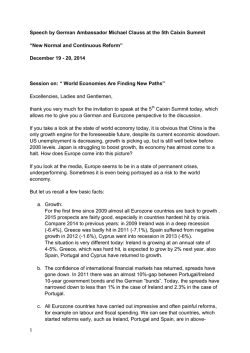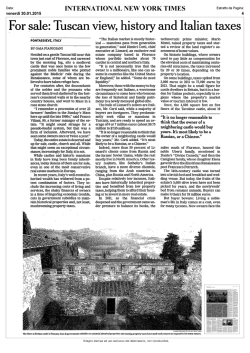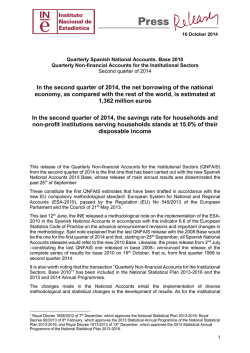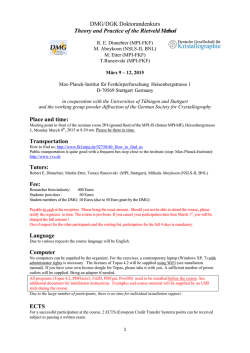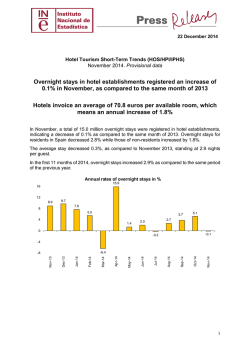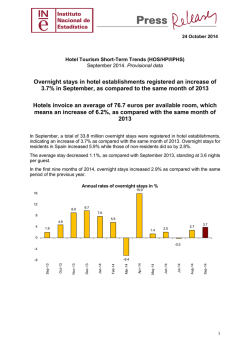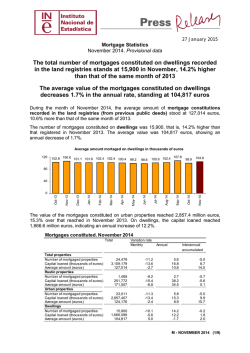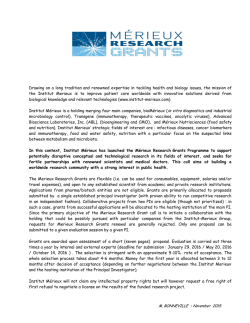
Jürgen Fitschen and Anshu Jain Co-Chief
Jürgen Fitschen and Anshu Jain Co-Chief Executives Deutsche Bank AG Preliminary financial results 2014 Frankfurt am Main, January 29, 2015 – Check against delivery – 2 Opening remarks (Strauss) Good morning everyone, and welcome to today’s press call. With me on the call are Jürgen Fitschen and Anshu Jain, our Co-CEOs, and Stefan Krause, our CFO and Head of Strategy and Organisational Development. As you all know, we have postponed our Annual Press Conference until the second quarter this year. This is so that, at that time, we can talk to you in more detail about the next phase of our strategy, which we are actively working on. So today, we want to focus on our results for the year 2014. First, Jürgen and Anshu will discuss the highlights of the year and our strategic progress so far. You will find the presentation on our website. After that, Jürgen, Anshu and Stefan will be happy to take your questions. If you have a question, please follow the operator’s directions. With that, I’d like to hand over to Jürgen Fitschen. Thank you Thorsten, and good morning. Let me start on page 2 by taking a step back, and looking at where we are at the end of 2014 versus when we started on this journey in 2012. We are a more stable bank: we have reduced balance sheet by 24% - over 500 billion Euros. We are a stronger bank: we’ve raised our core capital ratio from below 6% in early 2012 to 11.7%. We are a better balanced bank, with four businesses contributing more strongly and evenly to our results. We are a safer bank: we have further upgraded our technology and operations via our Operational Excellence Programme and by investing 3.6 billion Euros since 2012. We are a more responsible bank that is irreversibly committed to cultural change. So yes: some notable progress! On the other hand, we are not as profitable as we could be, for several reasons. Our operating environment is tough: some regulation continues to evolve, the Eurozone economy is still fragile and interest rates, already at record lows, got even lower in 2014. But not all challenges are external. Our litigation burden came down in 2014, but is still too high. Our Non-Core Operations Unit has delivered significant asset reduction but negatively impacts P&L. Together, litigation and NCOU impacted pretax profits by some 3.6 billion Euros in 2014. Furthermore, we have not yet delivered enough progress on cost reduction. Partly as a result, returns to shareholders are not yet where they should be. We are well aware that it’s crucial for us to anticipate and respond decisively to those challenges. We’re now working diligently, as planned, on the next phase of our strategic development and we’ll discuss that in the second quarter. So now let’s review both the achievements and the challenges of 2014. 3 First, let’s look at the bottom line, on page 3. Pre-tax profit rose from 1.5 billion Euros in 2013 to 3.1 billion Euros, and net income grew from 681 million Euros to 1.7 billion Euros. This reflects several factors: Robust performance in all four core businesses, despite tough conditions. Core Bank operating profitability remains close to record levels; Provisions for credit losses were significantly lower; and Litigation provisions were lower than in 2013 – we’re working hard to resolve the remaining litigation matters, although the timing of that is not under our control. However, lower litigation charges give a glimpse of the operating power of the bank once these issues are behind us, as we are confident they will be. Turning to page 4: we made clear when we launched Strategy 2015+ that building four strong business pillars was all-important. On this dimension, we reached a landmark in 2014: for the first time ever, all four core businesses delivered pre-tax profits over 1 billion Euros. Our earnings are stronger and better diversified: Investment banking has produced resilient profits in challenging conditions; Our businesses outside investment banking – PBC, GTB and Deutsche AWM – together contributed pre-tax profits of 3.6 billion Euros in 2014, up by around 50% versus 2012. Now let me hand over to Anshu. Thank you, Jürgen, and good morning. Let me begin with CB&S. In 2014, CB&S delivered outperformance on both an absolute and relative basis, gaining market share while substantially reducing leverage: Our Debt Sales & Trading business sustained its global top-3 status by revenues, despite tough European markets; Our Equities Sales & Trading captured market share and narrowed the revenue gap versus the top-3 peers; Our Corporate Finance business achieved our highest ever market share of 5.4%. In addition, we were the only major European-based house to gain share in the US corporate finance market during 2014. As we promised you, we dynamically managed our portfolio of businesses. We redeployed resources out of lower-return business such as commodities or singlename credit default swaps, and into higher-return businesses such as global prime finance, commercial real estate, or acquisition financing. 4 Nevertheless, as Jürgen just said, we continued to face headwinds. OpEx savings were more than offset by adjustments to pay mix required by regulation, and other regulatory spending. We made platform investments as we discussed with you back in May when launching our rights issue; sustained macro-economic headwinds in Europe impacted client business volumes; and low volatility affected revenues in our FX and Rates businesses. Let me turn next to PBC. The business performed well in a tough environment. Pre-tax profit fell 14% in 2014, primarily due to charges for the reimbursement of loan processing fees, which is a requirement for all German banks, and persistent cost challenges relating to OpEx and other platform investments. However: Revenues matched last year’s levels, despite record-low interest rates, reflecting strong revenues in fee-based businesses - investment & insurance products - and credit products; This reflected strong business volumes: we attracted post-crisis record inflows of securities products in 2014 – that’s a clear vote of trust from our customers. We also took in some 7 billion Euros of new customer deposits from successful deposit campaigns; Asset quality was strong, and we maintained provisions for credit losses at very low levels; We also made progress on digitization. We’re developing a true multichannel strategy which gives maximum choice for our clients and which we’ll discuss in a moment. GTB turned in a solid performance in 2014, despite a tough revenue and margin environment: We took advantage of a unique global platform to deliver robust performance in key growth regions, like the US and APAC – with doubledigit revenue growth in both India and greater China, and double-digit profit growth in the key US market; We grew volumes in key markets and products; The franchise was strong. In benchmark client surveys during 2014, we achieved top-ranking positions in key businesses – trade finance, cash management and investor services; We were first to offer Renminbi clearing in Frankfurt for German companies, an innovative way of supporting Chinese-German trade and German exporters. 5 That said, GTB also faced challenges. Low interest rates created margin pressure. Market activity was affected by ongoing geo-political uncertainties. Costs also reflected platform investments as we build out our coverage of corporate clients as we communicated in May. Let me turn finally to Deutsche AWM. We made clear, when we launched Strategy 2015+, that the restructuring of this business was going to be the most intensive. At that time, the business was not performing to its full potential, was up for strategic review and was losing client assets. In 2014, we began to see the benefits of our work: The business has sustained strong profit momentum since we started – from 154 million Euros pre-tax in 2012 to over 1 billion Euros in 2014; The business exceeded one trillion Euros in Assets under Management in 2014, thanks in part to four consecutive quarters of net money inflows, totaling 40 billion Euros. This represents a significant turnaround compared to the outflows of previous years, and a vote of confidence from clients; The strength of our global franchise was underlined by benchmark rankings in many areas, including leadership in our home market of Germany; We made progress in Wealth Management, where assets we manage for high net worth individuals grew by over 20% in the year. Our priority now is to build on this progress. Now let me say a few words on Germany. Across all our core businesses, our deep roots in our home market of Germany are a vital part of our vision. Of all mortgages provided to enable Germans to buy their homes, roughly one in seven is provided by Deutsche Bank; Of the active mutual funds and exchange-traded funds held by German private savers and investors, close to 30% are provided by Deutsche Bank; Deutsche Bank provided 21 of the DAX-30 companies with either strategic advisory or corporate financing services in 2014. We were involved in 16 out of the top-20 corporate finance transactions of 2014, twice as many as our nearest competitor, and our corporate finance market share was the highest since the financial crisis; We provided over 30 billion Euros of financing for German companies in 2014, through loans, debt capital or equity capital; 6 Against a background of global economic uncertainty, we helped some 20,000 German companies hedge their currency and other risks last year, 1,000 of these for the first time; Finally, let me discuss capital. 2014 was a year of significant capital strengthening. We improved our Common Equity Tier 1 ratio from 9.7% at the end of 2013 to 11.7%. That’s almost double where it was in early 2012 – below 6%. There were several highlights: We took decisive action on capital-raising. We raised 8.5 billion Euros of common equity in June. We raised 4.7 billion Euros of Additional Tier 1 capital, meeting strong demand from investors. As a result, we completed the bulk of our five billion Euro Additional Tier 1 capital-raising programme more than a year early. We sustained asset discipline. We continue to actively reduce our balance sheet. In the 4th quarter alone, reductions came to over 100 billion Euros adjusting for FX movements. This helped us strengthen our leverage ratio to 3.5% by the end of 2014. We passed the ECB’s Comprehensive Assessment comprehensively. The Stress Test showed we have one of the best capital buffers of any Eurozone bank in a stress scenario, and that was subsequently reinforced by our capital raise in June. The Asset Quality Review showed that no material adjustments were necessary to our capital ratios. We’re pleased with these achievements. That said, we recognise that regulation in this area continues to develop. The EBA’s Technical Standards, such as Prudential Valuation, will impact us when they are enacted. The transition to a Single Supervisory Mechanism is an important step toward a “level playing field” but is likely to affect regulation. Furthermore, we will need to respond to the requirements of Total Loss Absorption Capacity or ‘T-LAC’ when these are finalized. Additionally, the way risk-weighted assets are measured is still under review at the Basel level. In 2014, our risk weighted assets increased for reasons of methodology or policy. Now let me hand back to Jürgen. Turning to page 11, a few words on the contribution of our Non-Core Operations Unit, or NCOU: During 2014, NCOU reduced assets by nearly 40% to an all-time low of 39 billion Euros. We made some landmark disposals including BHF and The Cosmopolitan of Las Vegas; 7 Since its formation, NCOU has reduced assets by over 100 billion Euros, or 72%, and reduced risk weighted assets by 84 billion Euros. The unit has contributed regulatory capital accretion of 4.8 billion Euros – that’s equivalent to 110 basis points on our CET1 ratio; Clients are another key lever of our strategy. At last year’s Press Conference, we talked about how we reconfigured our organization around clients. During 2014, we built on this progress in several ways: In May, we committed 200 million Euros to digitize our retail platform. Our aim is to provide clients with seamless multi-channel experience combining branch and online access. And by the end of the year we were seeing results: fingerprint login allows clients to access their accounts without the need for a password. This feature was launched in November and has already been used 600,000 times by clients. Furthermore, we have made money transfers easier and faster through our ‘PhotoTAN’ app which is easily transferred to a mobile phone. In 2014, we had around 1 billion log-ins from customers via PCs, mobile telephones or tablets – around 3 million per day, and nearly 50% more than in 2012. We also intensified co-operation across businesses, working more than ever as partners to present ’one bank’ to the client. Deutsche AWM and PBC continued to collaborate on joint identification and development of business opportunities – a partnership which led to approximately 3,000 joint sales activities in 2014. CB&S and Deutsche AWM further developed the Corporate Finance Partnership which covers joint origination, distribution and execution for common clients; CB&S and GTB are also making progress on their joint initiative to improve our coverage of multinational corporations in the US market, which led to double-digit revenue growth among these clients and, in one campaign, 66 new mandates in 2014. As we said in Davos: a full-service business model has been an essential part of delivering an integrated service to clients and a core element of what we have delivered so far. Meanwhile, the dedicated Mittelstand unit which we announced in 2013 did business with around 5,000 new business clients in 2014, and saw healthy volume growth in all main products. Turning to page 13: cultural change is one of our fundamental strategic priorities, and 2014 was a year of execution. We further embedded cultural change into the way we operate, in several key aspects: We sustained our efforts to help restore trust in the banking industry. We continued to invest in strengthening our “three lines of defense” against future conduct issues, building up front-office supervisory capacity to some 700 people and plan to grow this to 1,000. In CB&S, we set up our Conduct and Control Group and put around 6,000 staff, some 90% of our bankers, 8 through dedicated compliance and risk culture workshops. In addition, more than 400, or 90% of our Managing Directors in Germany – key ‘culture carriers’ for us – have now completed our 2-day seminars organized with the Cologne Institute for Economic Research. Globally we carried out more than half a million “Compliance and Risk Culture” training sessions in 2014, up by one-third versus 2013. We also continued to change the way we do business. PBC introduced mortgages which protect clients from the impact of rising interest rates in today’s very low interest rate environment. CB&S restricted the sale of complex derivative products to some client groups and discontinued business with certain clients where we identified reputational risk or where business did not fit with our values. Furthermore, in 2014, we scrutinized over 1,200 transactions for their environmental or social impact. In 2011, that number was 70. Additionally, we continued to embed adherence to our values and beliefs in the way we manage our people. We introduced “Living the Values” awards to celebrate employees and teams whose conduct exemplifies our values. Nearly 500 people saw one or more ‘red flag’ incidents impact their performance assessment in 2014, up by around 50% versus 2013, and in some cases this affected pay and promotion. True cultural change depends on strong governance, and we strengthened our governance structure during 2014. As you see from page 14, we are attracting worldclass people, and we’re deploying them in a highly focused manner: We welcomed Marcus Schenck, formerly of Goldman Sachs, as CFO designate; We promoted Christian Sewing, our Head of Group Audit, to the Management Board with a mandate to focus on resolution of legacy litigation matters; On the GEC we strengthened our focus on strategy with the election of our strategy head, Fabrizio Campelli, and our focus on compliance and regulatory affairs by welcoming Sylvie Matherat and Nadine Faruque. We also added senior people in other key roles: Luc Frieden as ViceChairman, Karl-Georg Altenburg, formerly of JPMorgan as co-Head of Corporate Finance in EMEA, and JP Rangaswami, former CIO of Salesforce.com, as Chief Data Officer. We are under no illusions. Deep cultural change is a multi-year effort. However, we have made progress and we’re determined to continue on this journey. 9 Turning to page 15: for cost management, 2014 was a year of progress, but also challenges. We sustained momentum on our OpEx programme, which delivered savings of 1.3 billion Euros in 2014. That brings the cumulative savings total to 3.3 billion Euros – 400 million Euros ahead of our target of 2.9 billion Euros for the end of 2014. OpEx has been on or ahead of target for three consecutive years, and we’re pleased with that. However, we also faced challenges – most significantly, additional costs arising from the need to adapt to evolving regulation, which came to 1.3 billion Euros in 2014: Approximately 500 million Euros of these were temporary or ‘one-time’ – for example, adjusting our pay mix to comply with CRD4, and specific regulatory one-off charges; However, a significant proportion will be project-driven or ongoing – for example, IT projects to support regulatory reporting requirements or remediation; headcount increases to meet increased regulatory demand, and increasing bank levies. However, not all these cost increases are driven by regulation. As we communicated at the time of our capital raise, we also made investments in business growth and digitization. As a result of these challenges, our externally adjusted cost base went up slightly in 2014. So let me say clearly: in this tough environment, cost discipline is all-important, and we are not satisfied with where we are on costs. I’d now like to hand back to Anshu. Thank you, Jürgen. Let me summarise the year: 2014 was a year of some notable achievements. We strengthened our capital position, and saw this strength validated by the new pan-European regulator, the ECB. We made progress on reducing exposures. We achieved strong financial performance across all four core businesses, and we underlined the power of our client franchise. We made further progress on the multi-year journey of cultural change. Deutsche Bank now is a fundamentally different, and better, bank from when we started out. As Jürgen said – we’re safer, stronger, better balanced and irreversibly committed to cultural change. We are pleased with this. Nonetheless, challenges remain. Several factors continue to constrain profitability. Regulation continues to evolve, the Eurozone economy remains weak, and interest rates will likely persist at historic low levels. Litigation matters impacted our P&L in 2014, and some remain outstanding; we are working with our regulators to resolve these. NCOU continues to impact P&L. 10 In addition, our execution on cost reduction has not yet delivered the results we aim for. Partly as a result, we have not yet delivered to our investors the returns which they rightfully expect. These achievements, and these challenges, form the backdrop for the next phase of our strategy – so let us close with a few words on that process. This is a period of rigorous analysis, and it’s too early to talk about conclusions at this stage. Looking ahead, our strategy work comprises four main elements. First, an assessment of where we are – both achievements and challenges. Second, in-depth analysis of the operating environment: how have interest rates, the economic outlook, regulation and customer needs changed since 2012? Following this internal and external analysis, we will review the strategic implications for our individual businesses; and finally, the implications for the business portfolio. This will enable us to formulate concrete actions and targets, and we look forward to sharing more details with you in the second quarter at our Annual Press Conference. To conclude: we are confident, and determined, that we can and will deliver the Deutsche Bank which all our stakeholders expect and deserve. Thank you for your attention. Now let me hand back to Thorsten, and we look forward to your questions.
© Copyright 2026
